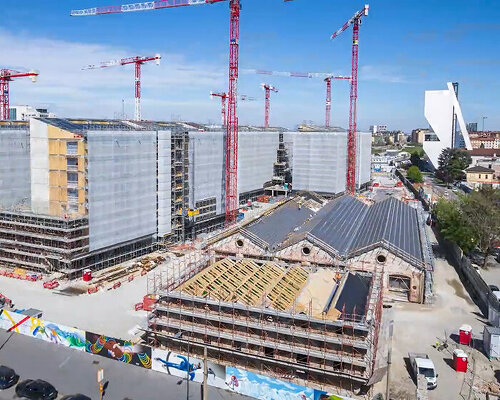Milan Olympic Village by SOM in Porta Romana nears completion
With just months to go before the opening of the Milano-Cortina 2026 Winter Olympic Games, Milan’s Olympic Village nears completion within the vast redevelopment of the former Porta Romana railway yard. Designed by Skidmore, Owings & Merrill (SOM), the village is set to host over 1,300 athletes during the Games before transforming into Italy’s largest publicly supported student housing complex (find designboom’s previous coverage here). The project responds to the pressing housing needs of the city but also highlights the role of large-scale events in driving long-term urban transformation.
Located between Via Ripamonti and Corso Lodi, in the Fondazione Prada district, the disused Porta Romana scalo was once a vast infrastructural void dividing Milan’s southern sector. The site is currently undergoing one of the most ambitious regeneration initiatives in Europe, coordinated by COIMA SGR and its institutional partners through the Porta Romana Fund. The wider redevelopment began in 2005 as part of the Scali Milano initiative, which sought to convert over one million square meters of obsolete railway land into new urban centralities. The Olympic Village, a key anchor within the masterplan by Outcomist and Michel Desvigne, with landscape input from Elizabeth Diller, marks a milestone in this decades-long process.
Milan’s Olympic Village nears completion | images courtesy of Scalo di Porta Romana
A fast-track conversion for a post-Olympic legacy
As of February 2025, all six residential buildings that make up the Olympic Village have been structurally completed, alongside the restoration of two historic railway buildings: the Squadra Rialzo and the Basilico warehouse, named after photographer Gabriele Basilico. Designed by the international architecture firm SOM with conversion in mind from the outset, the village will be handed over to Fondazione Milano Cortina 2026 six months ahead of the Games and returned immediately afterward for transformation into student housing— a record-setting turnaround for an Olympic facility.
The future student village will offer 1,700 beds, with 30% at subsidized rates. Thanks to support from COIMA’s ESG City Impact Fund and the Fondo Nazionale Abitare Sociale (FNAS), 450 of these units will be available at an average of €430/month, roughly 25% below market. The development has already been pre-qualified by the Italian Ministry of Universities as eligible for public funding under the National Recovery and Resilience Plan (PNRR), potentially reducing rents even further for up to 12 years.
the village is set to host over 1,300 athletes during the Games
A climate-conscious village for future generations
The Olympic Village is one of Italy’s most sustainable residential developments to date. Certified LEED Gold, the buildings achieve zero operational emissions thanks to advanced energy systems consisting of no fossil fuels, high-efficiency heat pumps, LED lighting, and a rooftop photovoltaic array producing 1 MW of power. Prefabricated timber facade panels reduce both construction time and environmental impact. Public green areas, designed by Desvigne, are fully integrated into the neighborhood network, promoting walkability and ecological continuity.
The internal programming, including fitness facilities, coworking areas, dining, and healthcare, will be converted into community-serving spaces after the Games. This approach ensures the Olympic legacy contributes directly to long-term social infrastructure.
the complex will turn into Italy’s largest publicly supported student housing complex after the games
Public and private alignment
The project is supported by a wide consortium of institutional stakeholders, including Cassa Forense, ENPAM, Fondazione Compagnia di San Paolo, Intesa Sanpaolo, and CDP Real Asset SGR. The residential component of the Porta Romana site will also include 320 affordable housing units, covering the housing needs of over 2,500 residents and aligning with Milan’s municipal housing strategies and Confindustria’s national sustainable housing program.
As Italy eyes its post-pandemic urban future, the Olympic Village at Porta Romana stands as an example of infrastructure designed to serve beyond spectacle.
redefining the role of large-scale events
the site is now undergoing one of the most ambitious regeneration initiatives in Europe
designed by Skidmore, Owings & Merrill (SOM)
the Olympic Village is a key anchor within the masterplan
converting over one million square meters of obsolete railway land into new urban centralities
a milestone in the decades-long process
six residential buildings that make up the Olympic Village
two historic railway buildings, the Squadra Rialzo and the Basilico warehouse, are restored
the Olympic Village is one of Italy’s most sustainable residential developments to date
project info:
name: Olympic Village Milano-Cortina 2026
architect: Skidmore, Owings & Merrill (SOM) | @skidmoreowingsmerrill
location: Porta Romana, Milan, Italy (more info here)
site area: 46,620 square meters
building gross area: 53,380 square meters
masterplan: Outcomist
landscape design: Michel Desvigne Paysagiste
landscape advisor: Elizabeth Diller | Diller Scofidio + Renfro | @diller_scofidio_renfro
developers: COIMA SGR, Covivio, Prada Holding
project partners: COIMA ESG City Impact Fund, CDP Real Asset SGR, Fondo Nazionale Abitare Sociale
The post milan’s porta romana olympic village nears completion with built-in student housing legacy appeared first on designboom | architecture & design magazine.

